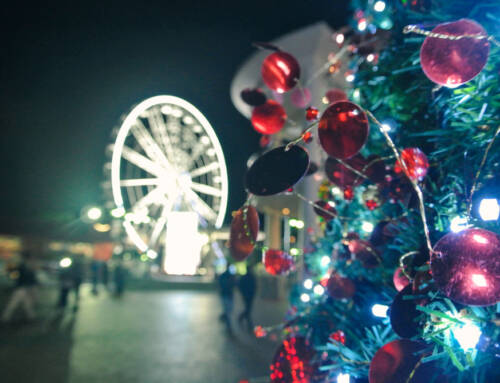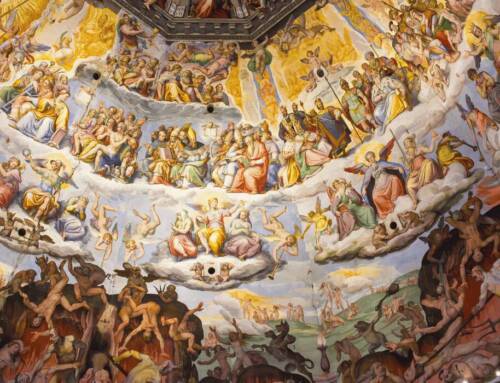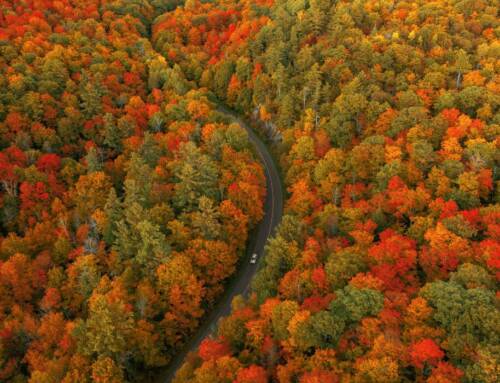In the heart of Southeast Asia, Cambodia unfolds as a tapestry of living history, deep jungles, endless rice paddies, and warm smiles that seem to defy the passage of time. If you want to travel to Southeast Asia to discover its most captivating side, you absolutely must see Cambodia. Imagine a sunrise over the jungle temples of Angkor? Or perhaps exploring the authentic traditions of its villages and its laid-back capital, Phnom Penh? While no destination is truly perfect, Cambodia comes very close.
Index
Why visit Cambodia?
Traveling to Cambodia isn’t just checking a destination off your list: it’s opening a door to the soul. This corner of Southeast Asia, marked by a history as harsh as it is moving, has a unique way of showcasing human resilience. Here, amidst ancient temples and green landscapes, life flourishes with a sincere smile, even after the deepest scars.
When your journey ends, and there is still much to explore, you’ll find it difficult to leave without feeling that something inside you has changed.
Perhaps it’s the calm of the Buddhist monks, wrapped in their saffron robes, walking in silence as if floating between centuries of history. Or maybe it’s the spark in the eyes of the children running barefoot among the ruins, making the ancient stones their playground. It might simply be that: the quiet magic of a country that not only welcomes visitors but embraces you with its soul and whispers that, despite everything, beauty persists. This is Cambodia.
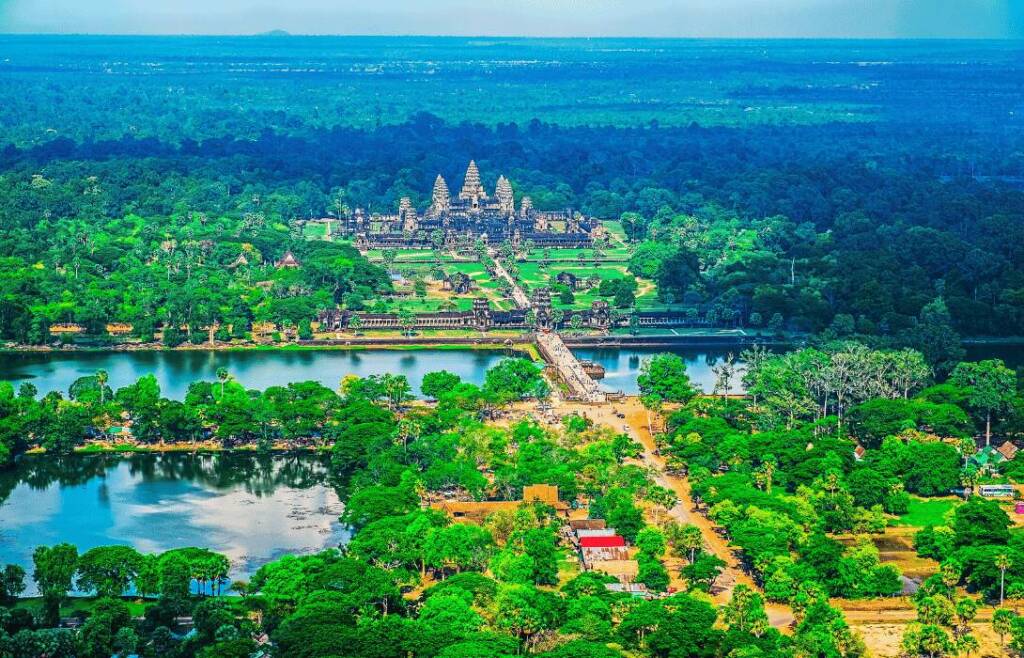
The temples of Angkor Wat
These temples are, very possibly, Cambodia’s biggest draw. They are certainly the most famous. These archaeological relics have attracted travelers to Cambodia for centuries. Seeing the sunrise over Angkor Wat is one of those experiences every traveler must have, only comparable to, for example, watching the Taj Mahal bathed in moonlight. No one can deny that a visit to the Angkor temples is a fundamental part of any traveler’s bucket list.
Angkor Wat is more than just a temple; it is the spiritual, cultural, and architectural heart of Cambodia. It stands as one of the most impressive monuments ever constructed by human hands, and an enduring testament to the greatness of the Khmer Empire. Few places in the world impress as much as Angkor Wat.
Angkor Wat: A glimpse into history
From around 800 AD until the mid-15th century, Angkor was the nucleus of the vast Khmer Empire. Its influence reached beyond modern Cambodia into large parts of what are now Thailand, Laos, and Vietnam. Here, each new king brought with him a new wave of monumental constructions. And amidst rice paddies and dense tropical jungles, dozens of temples scatter around the ancient fortified city of Angkor Thom, covering an area of nearly 400 square kilometers.
Until the 11th century, the empire’s main religion was Hinduism. Although Buddhism had a brief period of prominence, Hinduism returned in the 13th century, until Buddhism finally consolidated its definitive position with the decline of the empire.
In the Angkor temples, both religions have left their mark:
- Elaborate sculptures narrating passages from the Ramayana and the Mahabharata coexist with serene images of bodhisattvas.
- Altars that once held lingas, sacred symbols of the god Shiva, now display figures of Buddha.
- The Apsaras, the mythical celestial dancers of Hinduism, have crossed the religious border to become an essential element of Khmer Buddhist sacred art, and today, a national emblem of Cambodia. Their costumes, elaborate headdresses, and refined gestures remain alive in current performances, especially among dancers and in shows in general.
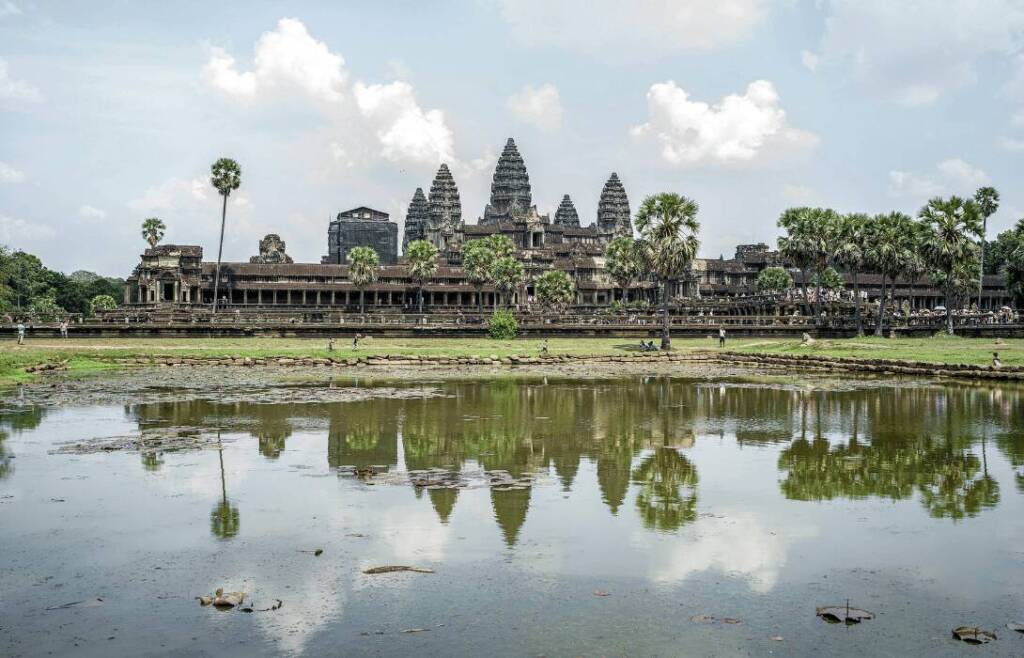
What to see in Angkor
If there is one place in the world where time dissolves, it is Angkor. It disappears between the roots of ancient trees and stones carved by ancestral hands. A labyrinth of temples and ancient cities whose magnitude and mystery seem to defy the centuries. Truthfully, we would need weeks to explore every corner of this archaeological treasure, and even then, secrets would remain. Walking among these ruins is not just a journey to a distant place; it is walking among gods, legends, and memories of a past that lives on in every stone, every root, and every face that seems to observe you from the tops of the towers.
Angkor is something you absolutely must see in Cambodia. Below we share some of the most emblematic sites that narrate the greatness of an empire that once ruled Southeast Asia.
Angkor Thom
The first stop takes you to the imposing Angkor Thom, the ancient walled city. Its main entrance is flanked by massive gates guarded by mythological figures. Inside, the Terrace of the Elephants reveals the history of a king who, from there, would observe processions and animal training.
Srah Srang
A few steps away, the majestic Srah Srang, known as the “royal bath,” stretches nearly a kilometer long. Its purpose was to sustain life for both humans and animals, except for elephants, according to an ancient 10th-century inscription. This place served not only as a water source but also as a spiritual meeting point.
Ta Prohm
But the true enigma lies in Ta Prohm, a temple where nature and history embrace. Silk-cotton and strangler fig trees emerge from the cracks of the ruins. They extend their roots throughout the complex, as if the jungle is reclaiming its place among the temples. It feels like walking in a dream where the walls intertwine with the branches, creating a captivating and mysterious atmosphere. Lara Croft famously visited here, and the world understood the temples’ grandeur thanks to cinema.
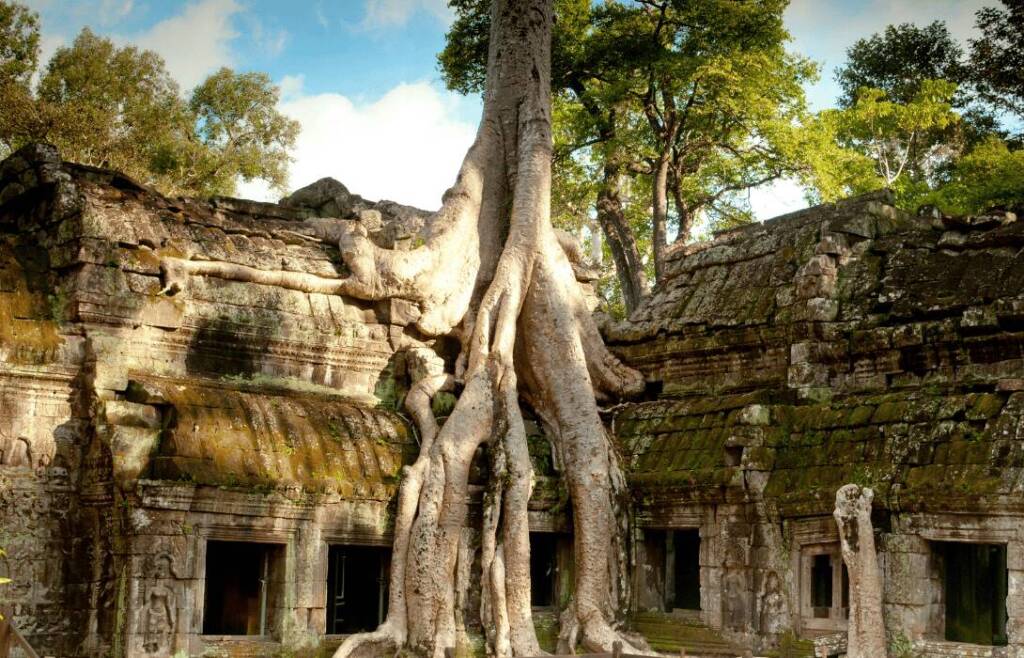
Bayon
No less impressive is Bayon, with its 37 towers decorated with gigantic faces of the Bodhisattva Lokesvara, watching over us from all angles, like guardians of this spiritual realm.
Banteay Srei
However, if there is one temple that leaves an indelible mark, it is Banteay Srei. Considered the most delicate and detailed of all, this temple of pink sandstone, sculpted more than a thousand years ago, stands out for its intricate carvings: the fingers of the Apsaras or the teeth of the monkey gods, each as tiny as a grain of rice. The perfection of Banteay Srei leaves any traveler breathless, who could spend the entire day reviewing every detail of the carvings and imagining the stories they hold.
Angkor is not just a destination; it is an encounter with history, nature, and the magic of a world that, though distant, continues to breathe in every corner.

Angkor Wat at Sunrise
Instagram or TikTok may have elevated many experiences that, in person, can be disappointing, but that is certainly not the case at Angkor Wat. Despite its popularity and the queues that can form at the entrance, watching the sunrise here is an unforgettable experience.
From Siem Reap, the closest city to the ruins, buses, motorcycles, and even tuk-tuks crowd together starting at 5 a.m., peak time, eager to depart before the sun itself. The bustling effort pays off when the first rays color the sky in shades of pink, red, and violet. They sharpen the edges of the temple’s towers, similar to corn cobs. In a moment poised between the mystical and the magical, the sun suddenly appears, and you almost have to pinch yourself to realize that what just happened before the eyes of even the most skeptical tourist is surreal—but real.
When the show ends, the curtain doesn’t fall; it opens to the perfect moment to visit the archaeological site with fewer tourists, as many people return to their accommodation for breakfast at that hour.
Bonus track: Some companies offer bike tours of the complex, allowing you to delve into corners that are only accessible on two wheels.
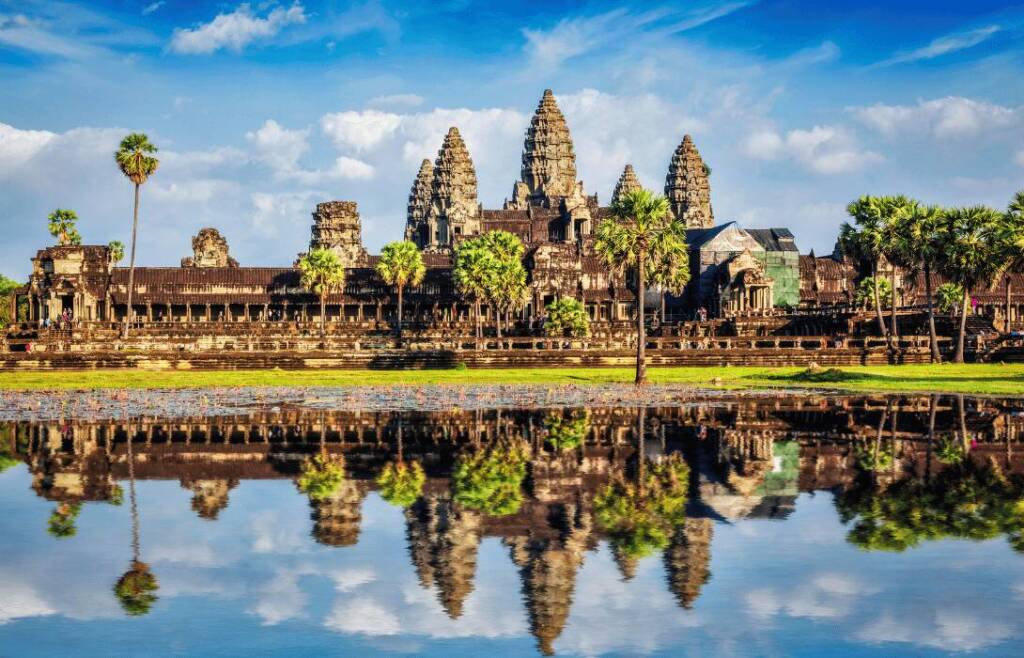
48 Hours in Siem Reap
Siem Reap is the gateway to the Angkor temples. It is a friendly and slightly chaotic city that is well worth a visit beyond the archaeological site. A couple of days is the perfect amount of time to invest in Siem Reap.
It is absolutely impossible to get bored in Siem Reap. With an appropriate size for walking, it is a small and lively place where tourists and locals mix on the bustling streets, in a spa for a relaxing massage, or at the outdoor sanctuaries. Furthermore, there is a vibrant street food scene, and the central market is a perfect place to shop and find a bargain among its jewelry and silk stalls.
What to see in Siem Reap
You don’t have to dig deep to notice the creative effervescence of this city. There are art galleries and cafes like Tribe, which exhibits works by artists like the famous graffiti artist Pure Evil, alongside paintings by local artists. You’ll also find small, excellent hotels and restaurants that double as hospitality schools for disadvantaged street children, such as Marum, Spoons, and Sala Baï. Although if you want a more personalized experience of the destination’s vibrant food scene, the best option is the Khmer Fine Dining food tour, where you also travel in a private tuk-tuk between different restaurants, cafes, and more casual bars.
No one should leave Siem Reap without trying the most essential Cambodian dishes, such as fish amok curry. You can even learn the recipe in a cooking class. Lily’s Secret Garden is a small, cozy culinary school in a Khmer village just outside the city center.
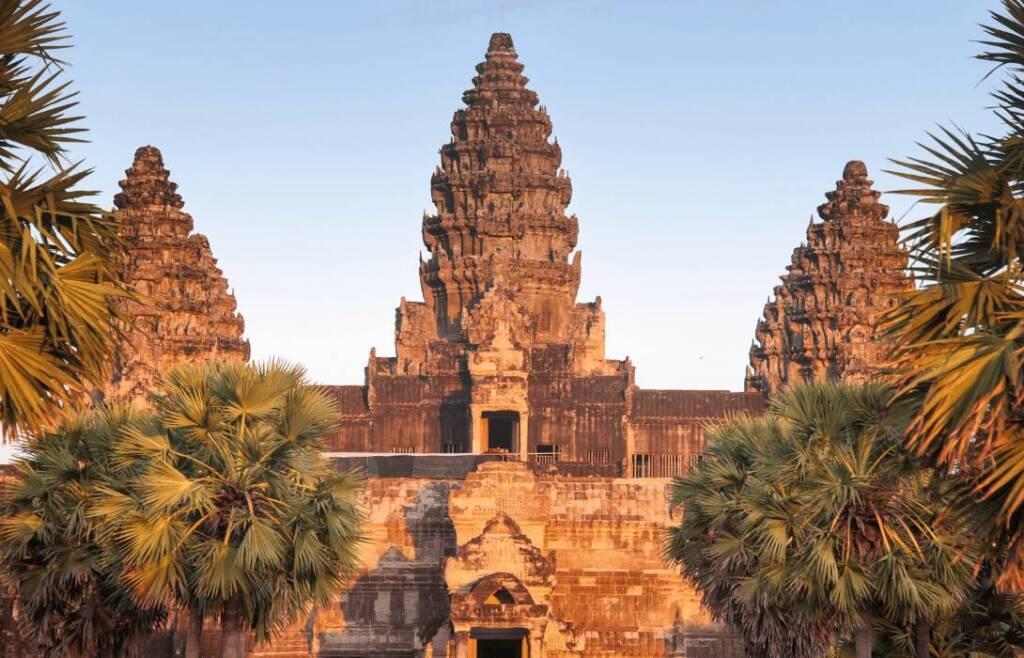
Accommodation in Siem Reap
The perfect rest can be found in either of the city’s two most emblematic and luxurious hotels. It is interesting how Siem Reap has become a luxury destination in recent years. Five-star hotels like the Amansara and the Raffles Grand Hotel d’Angkor are good examples of this.
The first, part of the Aman chain, is a former royal residence. It has been converted into a tranquil oasis that blends classic 1960s Khmer architecture with impeccable Aman service, Cambodian cuisine, and discreet luxury. Furthermore, it enjoys a privileged location near Angkor Wat, in the center of Siem Reap.
However, the Raffles Grand Hotel d’Angkor may boast all the fame. This 1930s property has survived all the recent historical upheavals in Cambodia and has hosted distinguished figures such as Charlie Chaplin, Somerset Maugham, the Clintons, and Michelle Obama. Following a remodel in 2019, it remains a historical monument and an authentic luxury hotel with cutting-edge services.
If all this weren’t enough, about a two-hour taxi ride from Siem Reap is the charming Battambang (more on this later). With its faded French colonial buildings, cafes, and relaxed atmosphere, the city is perfect for a day trip.
Phnom Penh: The resilience of a city
Phnom Penh, the capital of Cambodia, is a crossroads between the old and the new. The capital offers a relaxed and charming atmosphere with its riverside promenade, French colonial architecture, and café culture. You can explore the waterfront on foot, but any other journey is best done by tuk-tuk, which you should definitely hop into without hesitation, as they are the best means of urban transportation.
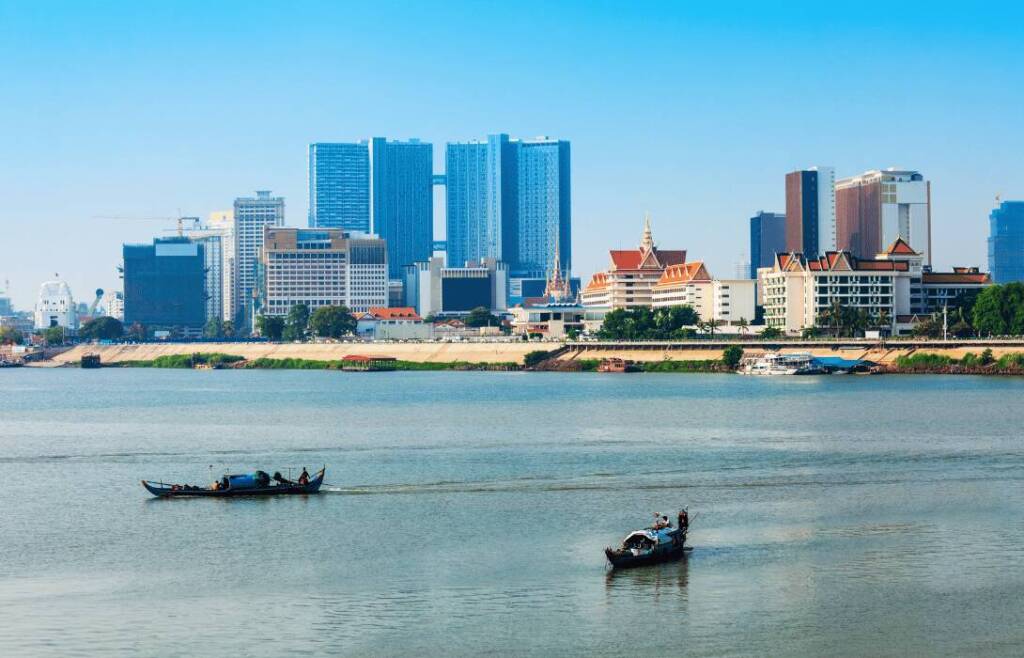
Museums in Phnom Penh
Here, recent history is strongly felt in places like the Tuol Sleng Genocide Museum and the Choeung Ek Killing Fields. These sites graphically recount the horrors of the Khmer Rouge regime.
You should also visit the National Museum of Cambodia. It houses an excellent collection of Khmer art and sculpture. Highlights include a statue of Jayavarman VII and a pair of monkeys from Koh Ker. A good tip to keep in mind is the option to hire a guide right at the door: it is inexpensive, friendly, and you will learn much more than with a simple audio guide.
As prepared as you might feel, it is impossible to be ready for the arduous visit to Tuol Sleng and Choeung Ek. Both are monuments to the genocide the Khmer Rouge inflicted nearly 50 years ago.

Gastronomy in Phnom Penh
Food lovers will find a kind of culinary nirvana here. To experience it, the best way to start the day is at Phnom Penh’s main market, having breakfast in the market’s food area or at the surrounding street stalls. Here you will find a reflection of what Cambodians eat daily, from grilled pork over rice with sweet and sour sauce and crunchy pickles to nom banh jok: fresh rice noodles with seasonal vegetables.
Kravanh
A luxurious culinary experience, yet at affordable prices, is found at Kravanh. It is not easy to forget, as the attempt to preserve and enhance Cambodian gastronomy here is a complete success. One of the most popular dishes on their menu is the snail amok. Although it can also be prepared with white fish wrapped in a banana leaf and steamed, the snails are more surprising.
Rosewood Phnom Penh
Following its inauguration in 2018, the Rosewood Phnom Penh immediately became a new icon of Cambodia’s historic capital. Perched atop the 39-story Vattanac Capital Tower, this modern hotel offers stunning 360-degree views of the city, stretching from the old French colonial quarter to the north to the Royal Palace to the southeast.
The sense of style begins at the base of the tower, home to the country’s only luxury shopping center. From there, you ascend to the hotel lobby on the 35th floor. Given its status as Cambodia’s tallest building, the Rosewood Phnom Penh is a popular meeting point for locals. They are attracted by the izakaya (Japanese pub) style dishes at Iza, French bistro food and Cambodian cuisine at Brasserie Louis, contemporary Chinese cuisine at Zhan Liang, and the exceptional grill and wine selection at Cuts on the 38th floor.
Battambang
Moving away from Cambodia’s most conventional tourist circuit, the country continues to surprise. Located in the west, about two hours by road from Siem Reap, is Battambang. This provincial capital has an overwhelming classic and picturesque charm: old-time architecture and pagodas located on the banks of a river. Best of all, while the city is one of the largest in the country, it remains less touristy.

What to see in Battambang
In Battambang, charming colonial-era buildings border the narrow streets, including the “pedestrian neighborhood” near the market. Art galleries, local and international cafes, shops, and bars crowd together in the old commercial houses. Battambang is an ideal place to explore the architecture and the destination’s flourishing art scene, discover local gastronomy, and use it as a base for excursions to the nearby countryside.
Rural life in Battambang and the floating villages
On the outskirts of Battambang, the landscape quickly transforms into a snapshot of villages and rice paddies, and, of course, one of the best ways to discover rural Cambodia. The nearby countryside is home to several Angkorian-era ruins, caves, mountains, waterfalls, and the famous “bamboo train.” Not far away, Tonlé Sap Lake beats like the heart of Cambodia. Entire communities live on its waters in floating houses, adapted to the rhythm of the water’s rise and fall. Navigating between these villages is discovering another way of life, governed by water and solidarity.
Gastronomy in Battambang
While Michelin inspectors may not stop in Battambang, its culinary offerings are modest but interesting and varied. Local restaurants are of good quality and affordable prices, a proposition demonstrated in places like White Rose and Chinese Noodle Dumpling. There are also some more exclusive options, especially in the Pedestrian District area, such as Choco l’Art, Bar Libations, and Vintage. In any of them, you can find dishes like lok lak (stir-fried meat with pepper sauce), a staple of Cambodian gastronomy.
The Night Market (markets, always markets), on the riverbank across from Phsar Nath, is an ideal place to try local cuisine. While the stalls and cafes are more aimed at locals, they are also welcoming to foreigners and very affordable. They offer noodle dishes, soups, sandwiches, Cambodian fruit shakes, and much more. If you head to the Provincial Museum at night, you will also find a similar group of food stalls. Here, street food is a religion.
What to see in Cambodia: The beaches
The paradisiacal Cambodia, the one with the beaches and private islands, is quite possibly the least expected Cambodia. While its beaches cannot compete with the paradisiacal islands of Thailand, Cambodia has much in its favor, including having managed to stop time, and even turn it back. For decades, the Cambodian coast managed to preserve its natural contours, largely due to its imperfections: a rocky and rugged coast, agitated waters, and few beaches.
Hotels on the Cambodian Beach
Hotels like Six Senses on Koh Krabey demonstrate that all that has changed, and that it is now also possible to travel here to relax and enjoy. This pioneer in sustainability brought a new, lush island refuge to Cambodia’s south coast, attracting travelers tired and exhausted by the temples thanks to its wellness options, water sports, and delicious local cuisine.
The delightful Six Senses, which only has 40 villas, is located on 12 hectares of lush private island on the borders of the Ream National Park, in southern Cambodia, 15 minutes by speedboat from the mainland. The surrounding waters come from the Gulf of Thailand and are warm year-round, although a bit rougher than one might assume.
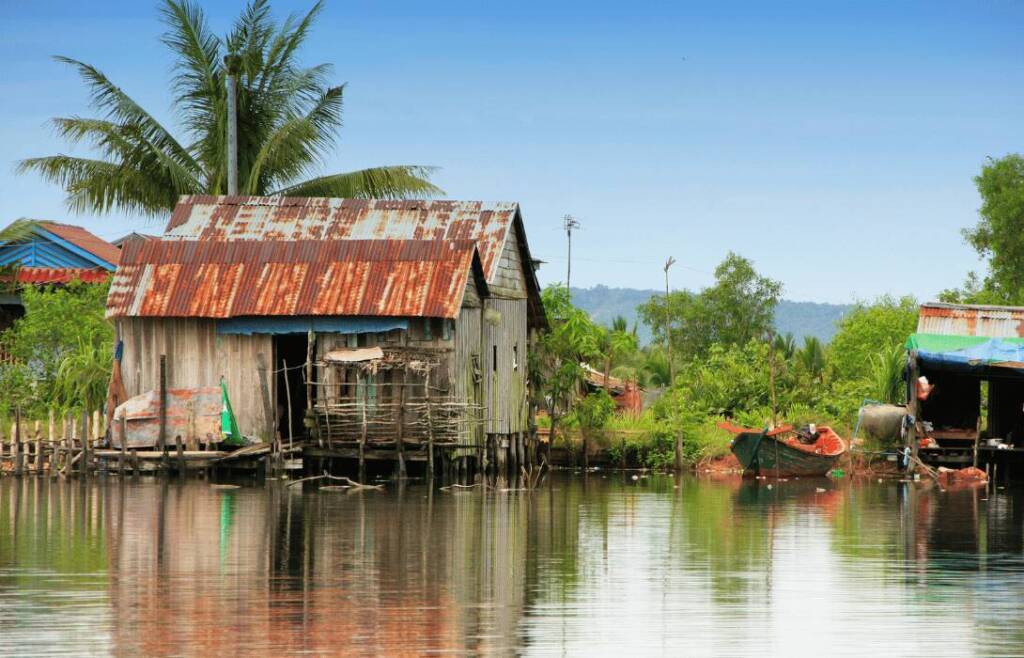
Today, new hotels have already opened on the mainland, but the coastal islands have long been the realm of fishing villages and tropical jungle. Song Saa Private Island is the first luxury resort to be established on the islands. This beautiful resort is a pioneer of ethical luxury on Cambodia’s south coast. It is truly a remote place nestled in the heart of the glittering Koh Rong Archipelago. It features 24 spacious thatched-roof villas, a fascinating spa, and a wide variety of magical local experiences. An eco-resort where you can sleep over the sea and feel like Robinson Crusoe for a few days, with all kinds of amenities, of course.
Other options to see in Cambodia
There are a series of coastal towns along the shore, such as Kampot, a haven on the Teuk Chhu River with Chinese shop-house architecture and French colonial villas that are quite neglected but tremendously charming. Further on is Kep, where it is advisable to rent a bicycle to cycle along the coastal road and see the abandoned seafront villas from the 50s and 60s that belonged to Cambodian aristocrats and French expatriates.

What is the best time to travel to Cambodia?
The best time to travel to Southeast Asia will depend on your plans, but you must take the seasons of each country into account. In this case, Cambodia’s climate is marked by the tropical monsoon, which divides the year into several seasons:
Dry Season (November to March):
- This is the best time to travel. Temperatures are milder (between $20^\circ\text{C}$ and $30^\circ\text{C}$), the sky is usually clear, and there is hardly any rain.
- This makes it the perfect time to visit the Angkor temples and travel the country comfortably.
- Of course, it is high season, so you will find more tourists and higher prices for hotels and flights.
Hot Season (April to June):
- Temperatures rise and easily exceed $35^\circ\text{C}$, especially in April and May.
- Although the heat can be intense, there is hardly any rain, allowing you to travel without major setbacks.
- It is a good option if you want to avoid the high-season crowds and get lower prices.
Rainy Season (July to October):
- This coincides with the monsoon, which means frequent rains (often at the end of the day), more humidity, and fewer hours of sun.
- However, it is a time with less tourism, the landscapes are greener, and the temples look spectacular amidst the vegetation.
- Furthermore, prices drop considerably.
The best time is generally from November to March, when the climate is most pleasant. But if you are looking for a more affordable, less crowded trip full of green landscapes, traveling in the rainy season can also be a great experience.
How many days should you spend in Cambodia?
The ideal trip duration depends on the interests of each traveler, as there is much to see in Cambodia. But in general:
- 3 to 5 days: Enough to visit Siem Reap and explore the main temples of Angkor, including Angkor Wat, Bayon, and Ta Prohm.
- 7 to 10 days: Allows you to combine Angkor with Phnom Penh, the capital, where the Royal Palace, the Silver Pagoda, and the historical museums stand out.
- 2 weeks or more: The ideal for those who want a more complete tour, adding less touristy places like Battambang, Kampot, Koh Rong (paradise island in the Gulf of Thailand), or the natural parks of the northeast.
In summary, if you only want to see the essentials, dedicate at least 4 or 5 days. But if you are looking for a deeper experience that combines temples, history, nature, and beaches, we recommend a minimum of 10 days. If you have more time, we recommend exploring a 15-day route through Vietnam and Cambodia.

Discover Cambodia safely with Heymondo
Now you know what to see in Cambodia, and you understand that it is not just a destination to visit; it is a journey that is felt in every corner. From the majesty of Angkor Wat at sunrise, through the vibrant energy of Phnom Penh, to the calm of its beaches and paradisiacal islands, this country combines history, culture, and nature in a unique way.
But as with any journey, unexpected events can occur: a flight delay, an illness during the trip, or a setback with luggage arrival. Therefore, having travel insurance will give you the peace of mind of knowing that you are always protected. With Heymondo, you travel with the security of having included:
- 24/7 Medical assistance in English
- Medical expenses coverage up to $10,000,000 USD
- Repatriation and early return included
- Luggage theft and damage up to $2,500 USD
- Trip cancellation up to $7,000 USD
Discover Angkor, experience Cambodia, and do it safely with Heymondo. Because the true freedom of travel lies in doing so without worries.
Featured stories



